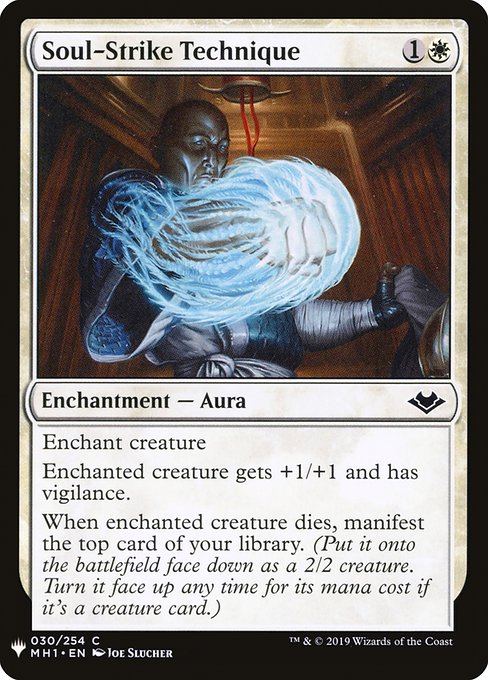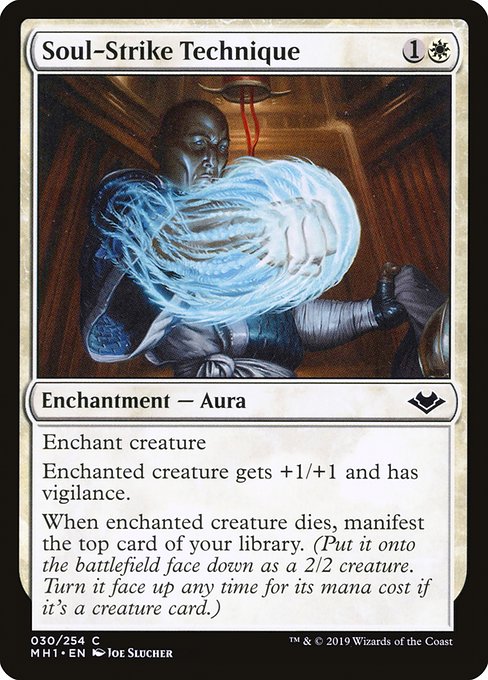standard
future
historic
gladiator
pioneer
explorer
modern
legacy
pauper
vintage
penny
commander
brawl
historicbrawl
alchemy
paupercommander
duel
oldschool
premodern
Rulings
Any time you have priority, you may turn a manifested creature face up by revealing that it’s a creature card (ignoring any type-changing effects that might be applying to it) and paying its mana cost. This is a special action. It doesn’t use the stack and can’t be responded to.
If a face-down permanent you control leaves the battlefield, you must reveal it. You must also reveal all face-down spells and permanents you control if you leave the game or if the game ends.
Because face-down creatures don’t have a name, they can’t have the same name as any other creature or share any creature types with any other creature, even another face-down creature.
The face-down characteristics of a permanent are copiable values. If another object becomes a copy of a face-down creature or if a token is created that’s a copy of a face-down creature, that new object is a 2/2 colorless face-up creature with no abilities.
A permanent that turns face up changes characteristics but is otherwise the same permanent. Turning a permanent face up doesn’t change whether that permanent is tapped or untapped. Spells and abilities that were targeting that permanent still target it, and Auras and Equipment that were attached to the permanent are still attached to it. If anything now targets or is attached to the creature illegally, the game rules will clean this up as appropriate.
The face-down permanent is a 2/2 creature with no name, mana cost, creature types, or abilities. It’s colorless and has a mana value of 0. Other effects that apply to the permanent can still grant or change any of these characteristics.
If an effect tries to return a face-down creature to the battlefield after it leaves (such as Astral Drift’s delayed triggered ability), that effect returns the card face up. If it tries to put an instant or sorcery card onto the battlefield this way, that card remains in its current zone instead.
Because the permanent is on the battlefield both before and after it’s turned face up, turning a permanent face up doesn’t cause any enters-the-battlefield abilities to trigger.
At any time, you can look at a face-down permanent you control. You can’t look at face-down permanents you don’t control unless an effect instructs you to do so.
If a face-down permanent you control leaves the battlefield, you must reveal it. You must also reveal all face-down spells and permanents you control if you leave the game or if the game ends.
Because face-down creatures don’t have a name, they can’t have the same name as any other creature or share any creature types with any other creature, even another face-down creature.
The face-down characteristics of a permanent are copiable values. If another object becomes a copy of a face-down creature or if a token is created that’s a copy of a face-down creature, that new object is a 2/2 colorless face-up creature with no abilities.
A permanent that turns face up changes characteristics but is otherwise the same permanent. Turning a permanent face up doesn’t change whether that permanent is tapped or untapped. Spells and abilities that were targeting that permanent still target it, and Auras and Equipment that were attached to the permanent are still attached to it. If anything now targets or is attached to the creature illegally, the game rules will clean this up as appropriate.
The face-down permanent is a 2/2 creature with no name, mana cost, creature types, or abilities. It’s colorless and has a mana value of 0. Other effects that apply to the permanent can still grant or change any of these characteristics.
If an effect tries to return a face-down creature to the battlefield after it leaves (such as Astral Drift’s delayed triggered ability), that effect returns the card face up. If it tries to put an instant or sorcery card onto the battlefield this way, that card remains in its current zone instead.
Because the permanent is on the battlefield both before and after it’s turned face up, turning a permanent face up doesn’t cause any enters-the-battlefield abilities to trigger.
At any time, you can look at a face-down permanent you control. You can’t look at face-down permanents you don’t control unless an effect instructs you to do so.
Rulings
Any time you have priority, you may turn a manifested creature face up by revealing that it’s a creature card (ignoring any type-changing effects that might be applying to it) and paying its mana cost. This is a special action. It doesn’t use the stack and can’t be responded to.
If a face-down permanent you control leaves the battlefield, you must reveal it. You must also reveal all face-down spells and permanents you control if you leave the game or if the game ends.
Because face-down creatures don’t have a name, they can’t have the same name as any other creature or share any creature types with any other creature, even another face-down creature.
The face-down characteristics of a permanent are copiable values. If another object becomes a copy of a face-down creature or if a token is created that’s a copy of a face-down creature, that new object is a 2/2 colorless face-up creature with no abilities.
A permanent that turns face up changes characteristics but is otherwise the same permanent. Turning a permanent face up doesn’t change whether that permanent is tapped or untapped. Spells and abilities that were targeting that permanent still target it, and Auras and Equipment that were attached to the permanent are still attached to it. If anything now targets or is attached to the creature illegally, the game rules will clean this up as appropriate.
The face-down permanent is a 2/2 creature with no name, mana cost, creature types, or abilities. It’s colorless and has a mana value of 0. Other effects that apply to the permanent can still grant or change any of these characteristics.
If an effect tries to return a face-down creature to the battlefield after it leaves (such as Astral Drift’s delayed triggered ability), that effect returns the card face up. If it tries to put an instant or sorcery card onto the battlefield this way, that card remains in its current zone instead.
Because the permanent is on the battlefield both before and after it’s turned face up, turning a permanent face up doesn’t cause any enters-the-battlefield abilities to trigger.
At any time, you can look at a face-down permanent you control. You can’t look at face-down permanents you don’t control unless an effect instructs you to do so.
If a face-down permanent you control leaves the battlefield, you must reveal it. You must also reveal all face-down spells and permanents you control if you leave the game or if the game ends.
Because face-down creatures don’t have a name, they can’t have the same name as any other creature or share any creature types with any other creature, even another face-down creature.
The face-down characteristics of a permanent are copiable values. If another object becomes a copy of a face-down creature or if a token is created that’s a copy of a face-down creature, that new object is a 2/2 colorless face-up creature with no abilities.
A permanent that turns face up changes characteristics but is otherwise the same permanent. Turning a permanent face up doesn’t change whether that permanent is tapped or untapped. Spells and abilities that were targeting that permanent still target it, and Auras and Equipment that were attached to the permanent are still attached to it. If anything now targets or is attached to the creature illegally, the game rules will clean this up as appropriate.
The face-down permanent is a 2/2 creature with no name, mana cost, creature types, or abilities. It’s colorless and has a mana value of 0. Other effects that apply to the permanent can still grant or change any of these characteristics.
If an effect tries to return a face-down creature to the battlefield after it leaves (such as Astral Drift’s delayed triggered ability), that effect returns the card face up. If it tries to put an instant or sorcery card onto the battlefield this way, that card remains in its current zone instead.
Because the permanent is on the battlefield both before and after it’s turned face up, turning a permanent face up doesn’t cause any enters-the-battlefield abilities to trigger.
At any time, you can look at a face-down permanent you control. You can’t look at face-down permanents you don’t control unless an effect instructs you to do so.
Your collection? Your decks?
Want to manage your collection and/or create decks?


 0
0
 0.05€
0.05€
